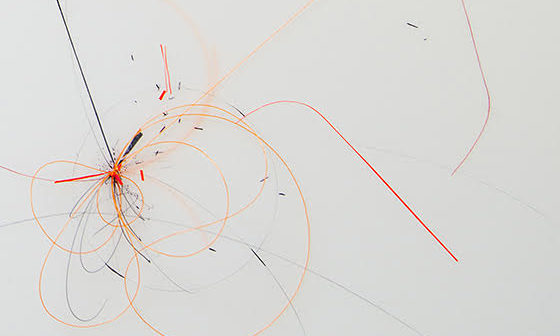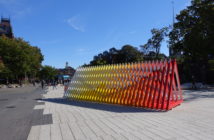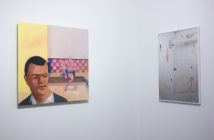Sidetracked, which occupies the storefront gallery in Watertown, Drive-by Projects, is a group show featuring work by Katherine Mitchell DiRico, Mike Witt and Andy Bablo. Though they use quite different materials, these artists address communication and modes of transmission in a way that is both current and timeless.
Though dealing with a theme explored by others for decades - arguably centuries - Sidetracked feels especially topical. The innovation that allows us to become more connected can also kill its predecessors while absorbing it, all while presenting new problems. In the era of “fake news” and data collecting, these artists are exploring the questions we should be asking ourselves as we aim to progress and perfect communication.
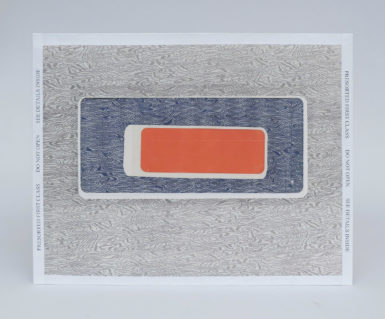
Mike Witt, Untitled, 2016, poster board, saved business envelopes, printed paper, 10 x13”
Witt’s nesting envelopes, hung in a salon style, are the result of the artist’s interest in correspondence through traditional mail as much as of the intriguing patterns used to keep sensitive information private. Witt’s work makes you question the last time you received a letter that wasn’t a bill or a spam mail. It also draws attention to how elegantly information can be blocked from view while it is passed from sender to recipient - something surely missed in digital communication. Witt’s revealing of the inner workings of these envelopes by inverting them and highlighting their design through his nesting technique reminds us of a time when corded landlines were the norm. We are prompted to think of what has been gained and what has been lost as we push further away from the art of handwritten news and sentiments.
Directly across from Witt’s envelopes are DiRico’s mixed-media works. Gallery owners Beth Kantrowitz and Kathleen O’Hara write that her work arises from “instinctive gestures used to communicate between mother and child.” This is apparent in the gestural marks that at first come across as frantic and confused. The bright orange fishing wire DiRico employs extends into the viewer’s space and augments the confusion. In some places, portions of wire are centered on one point, but loop out from this nucleus, as if representing a minuscule explosion. In others, pieces ramble across the canvas, pinned down by slivers of reflective silver or fluorescent orange. It is a sort of symbolic mapping of communication, as if DiRico is trying to make sense, pin down and formalize thoughts as they travel from one person to another. The ambiguity reflects the idea that there is always room for something to be lost in translation; as we move from thought to speech, we increase the chance for miscommunication, which complicates our relationships.

Katherine Mitchell DiRico, Ethics of Interruption, figure f, 2017
graphite and privacy screen on plastic, 25" x 40"
Photo Credit: Sarah Gaw
DiRico’s use of privacy tape serendipitously echoes Witt’s fascination with material that obscures messages. Neither of them are actually masking any concrete information from the viewer (that we know of), but use of these materials could be a seen as a reaction to the privacy that is slipping through our fingers quite quickly. In different ways, their work alludes to our tendency to try to maintain privacy in an age when it’s nearly impossible to do while maintaining meaningful connections.
In contrast, Balbo’s LED lightbox seductively emits a spectrum of colors, which we can only view through the tiny holes on its face. On either end of the rectangular box mounted at about average eye level, Balbo installed minuscule vinyl dots that seem to burst out of their container. Like DiRico’s wire, the dots introduce ideas of uncertainty and breaking through convention. The LED glow is reminiscent of the blue light of a TV, computer or phone screen. Watching the lights change from a few steps away is mesmerizing, yet the mechanism behind the glow remains a mystery. Again, the theme of masking and obscuring comes into play. The holes only reveal so much - unlike DiRico and Witt, whose materials allude to the idea of privacy, Balbo has achieved it.
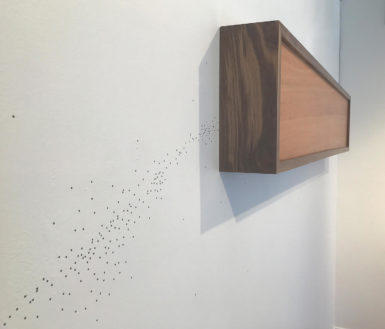
Andy Bablo, Feeble Cognition, 2017, African mahogany, black walnut and LED lighting, 12x58x5”
The artists’ work occupies its own small slice of gallery wall, which results in a lively dialogue between each that characterizes the best group shows. The works here confront themes of human connection and how that informs socialization in a quiet, subtle tone. Sidetracked is not a loud, rambunctious installation. The longer one looks, the more notions of privacy and process bubble up to the surface. What Kantrowitz and O’Hara bring together is a grouping of introspective works that are calm, even when seemingly chaotic.
Sidetracked is on view through May 13.

